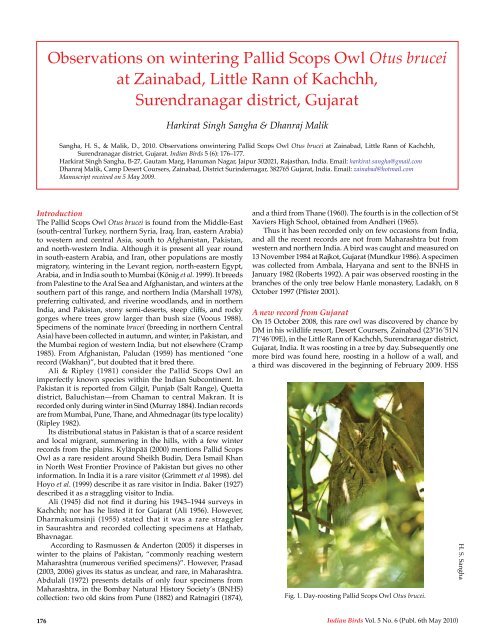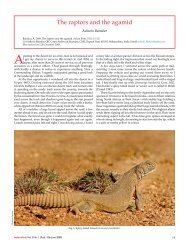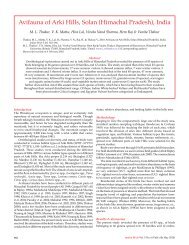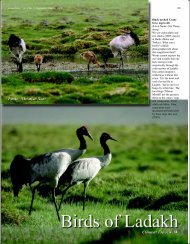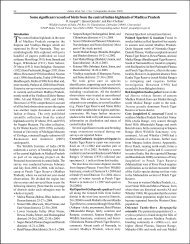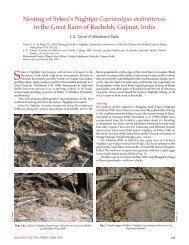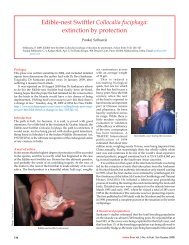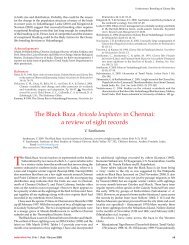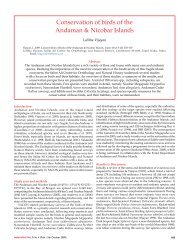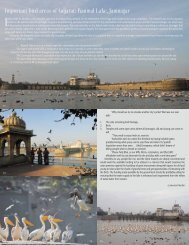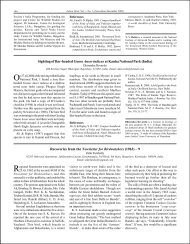Observations on wintering Pallid Scops Owl Otus ... - Indian Birds
Observations on wintering Pallid Scops Owl Otus ... - Indian Birds
Observations on wintering Pallid Scops Owl Otus ... - Indian Birds
Create successful ePaper yourself
Turn your PDF publications into a flip-book with our unique Google optimized e-Paper software.
<str<strong>on</strong>g>Observati<strong>on</strong>s</str<strong>on</strong>g> <strong>on</strong> <strong>wintering</strong> <strong>Pallid</strong> <strong>Scops</strong> <strong>Owl</strong> <strong>Otus</strong> brucei<br />
at Zainabad, Little Rann of Kachchh,<br />
Surendranagar district, Gujarat<br />
Harkirat Singh Sangha & Dhanraj Malik<br />
Sangha, H. S., & Malik, D., 2010. <str<strong>on</strong>g>Observati<strong>on</strong>s</str<strong>on</strong>g> <strong>on</strong><strong>wintering</strong> <strong>Pallid</strong> <strong>Scops</strong> <strong>Owl</strong> <strong>Otus</strong> brucei at Zainabad, Little Rann of Kachchh,<br />
Surendranagar district, Gujarat. <strong>Indian</strong> <strong>Birds</strong> 5 (6): 176–177.<br />
Harkirat Singh Sangha, B-27, Gautam Marg, Hanuman Nagar, Jaipur 302021, Rajasthan, India. Email: harkirat.sangha@gmail.com<br />
Dhanraj Malik, Camp Desert Coursers, Zainabad, District Surindernagar, 382765 Gujarat, India. Email: zainabad@hotmail.com<br />
Manuscript received <strong>on</strong> 5 May 2009.<br />
Introducti<strong>on</strong><br />
The <strong>Pallid</strong> <strong>Scops</strong> <strong>Owl</strong> <strong>Otus</strong> brucei is found from the Middle-East<br />
(south-central Turkey, northern Syria, Iraq, Iran, eastern Arabia)<br />
to western and central Asia, south to Afghanistan, Pakistan,<br />
and north-western India. Although it is present all year round<br />
in south-eastern Arabia, and Iran, other populati<strong>on</strong>s are mostly<br />
migratory, <strong>wintering</strong> in the Levant regi<strong>on</strong>, north-eastern Egypt,<br />
Arabia, and in India south to Mumbai (König et al. 1999). It breeds<br />
from Palestine to the Aral Sea and Afghanistan, and winters at the<br />
southern part of this range, and northern India (Marshall 1978),<br />
preferring cultivated, and riverine woodlands, and in northern<br />
India, and Pakistan, st<strong>on</strong>y semi-deserts, steep cliffs, and rocky<br />
gorges where trees grow larger than bush size (Voous 1988).<br />
Specimens of the nominate brucei (breeding in northern Central<br />
Asia) have been collected in autumn, and winter, in Pakistan, and<br />
the Mumbai regi<strong>on</strong> of western India, but not elsewhere (Cramp<br />
1985). From Afghanistan, Paludan (1959) has menti<strong>on</strong>ed “<strong>on</strong>e<br />
record (Wakhan)”, but doubted that it bred there.<br />
Ali & Ripley (1981) c<strong>on</strong>sider the <strong>Pallid</strong> <strong>Scops</strong> <strong>Owl</strong> an<br />
imperfectly known species within the <strong>Indian</strong> Subc<strong>on</strong>tinent. In<br />
Pakistan it is reported from Gilgit, Punjab (Salt Range), Quetta<br />
district, Baluchistan—from Chaman to central Makran. It is<br />
recorded <strong>on</strong>ly during winter in Sind (Murray 1884). <strong>Indian</strong> records<br />
are from Mumbai, Pune, Thane, and Ahmednagar (its type locality)<br />
(Ripley 1982).<br />
Its distributi<strong>on</strong>al status in Pakistan is that of a scarce resident<br />
and local migrant, summering in the hills, with a few winter<br />
records from the plains. Kylänpää (2000) menti<strong>on</strong>s <strong>Pallid</strong> <strong>Scops</strong><br />
<strong>Owl</strong> as a rare resident around Sheikh Budin, Dera Ismail Khan<br />
in North West Fr<strong>on</strong>tier Province of Pakistan but gives no other<br />
informati<strong>on</strong>. In India it is a rare visitor (Grimmett et al 1998). del<br />
Hoyo et al. (1999) describe it as rare visitor in India. Baker (1927)<br />
described it as a straggling visitor to India.<br />
Ali (1945) did not find it during his 1943–1944 surveys in<br />
Kachchh; nor has he listed it for Gujarat (Ali 1956). However,<br />
Dharmakumsinji (1955) stated that it was a rare straggler<br />
in Saurashtra and recorded collecting specimens at Hathab,<br />
Bhavnagar.<br />
According to Rasmussen & Andert<strong>on</strong> (2005) it disperses in<br />
winter to the plains of Pakistan, “comm<strong>on</strong>ly reaching western<br />
Maharashtra (numerous verified specimens)”. However, Prasad<br />
(2003, 2006) gives its status as unclear, and rare, in Maharashtra.<br />
Abdulali (1972) presents details of <strong>on</strong>ly four specimens from<br />
Maharashtra, in the Bombay Natural History Society’s (BNHS)<br />
collecti<strong>on</strong>: two old skins from Pune (1882) and Ratnagiri (1874),<br />
and a third from Thane (1960). The fourth is in the collecti<strong>on</strong> of St<br />
Xaviers High School, obtained from Andheri (1965).<br />
Thus it has been recorded <strong>on</strong>ly <strong>on</strong> few occasi<strong>on</strong>s from India,<br />
and all the recent records are not from Maharashtra but from<br />
western and northern India. A bird was caught and measured <strong>on</strong><br />
13 November 1984 at Rajkot, Gujarat (Mundkur 1986). A specimen<br />
was collected from Ambala, Haryana and sent to the BNHS in<br />
January 1982 (Roberts 1992). A pair was observed roosting in the<br />
branches of the <strong>on</strong>ly tree below Hanle m<strong>on</strong>astery, Ladakh, <strong>on</strong> 8<br />
October 1997 (Pfister 2001).<br />
A new record from Gujarat<br />
On 15 October 2008, this rare owl was discovered by chance by<br />
DM in his wildlife resort, Desert Coursers, Zainabad (23º16´51N<br />
71º46´09E), in the Little Rann of Kachchh, Surendranagar district,<br />
Gujarat, India. It was roosting in a tree by day. Subsequently <strong>on</strong>e<br />
more bird was found here, roosting in a hollow of a wall, and<br />
a third was discovered in the beginning of February 2009. HSS<br />
Fig. 1. Day-roosting <strong>Pallid</strong> <strong>Scops</strong> <strong>Owl</strong> <strong>Otus</strong> brucei.<br />
H. S. Sangha<br />
176<br />
<strong>Indian</strong> <strong>Birds</strong> Vol. 5 No. 6 (Publ. 6th May 2010)
Sangha & Malik: <strong>Pallid</strong> <strong>Scops</strong> <strong>Owl</strong><br />
Dhanraj Malik<br />
observed them from 29 to 31 December 2008, and <strong>on</strong> 31 January<br />
2009.<br />
Descripti<strong>on</strong><br />
<strong>Scops</strong>-owls (Genus <strong>Otus</strong>) have an intricate pattern of colouring<br />
resembling bark and dry leaves, which camouflage them<br />
appropriately am<strong>on</strong>g regi<strong>on</strong>al flora, while it roosts in the daytime<br />
(Marshall 1978). The bird exhibits a whole cline of colour variati<strong>on</strong><br />
from sandier to grey plumages (Mikkola 1983). The bird at<br />
Zainabad was the nominate brucei, rather grey with sharply<br />
defined streaks. Of the four distinct size-groups at least nominate<br />
brucei migrates to northern India (Cramp 1985). The identificati<strong>on</strong><br />
was fairly straightforward facilitated by the best of views and<br />
good light c<strong>on</strong>diti<strong>on</strong>s.<br />
One bird, roosting upright in a tree, appeared rather slim, with<br />
its plumage sleeked and its rounded ear-tufts raised (Fig. 1).<br />
However, at night it appeared dumpier, with relaxed body<br />
plumage, a more rounded head, and ear-tufts <strong>on</strong>ly slightly raised<br />
with feathers of head held loose (Figs. 2–3).<br />
Overall the bird looked creamy-grey with fine sharp black<br />
streaks. Under parts were comparatively paler with black<br />
striati<strong>on</strong>s thicker and l<strong>on</strong>ger <strong>on</strong> breast side. These appeared to<br />
become narrower and sharper towards tips, whereas <strong>on</strong> Eurasian<br />
<strong>Scops</strong> <strong>Owl</strong> <strong>Otus</strong> scops they normally become slightly broader and<br />
diffuse.<br />
The facial disc appeared paler, greyer and much plainerlooking<br />
with tiny grey specks, and short whitish eyebrows.<br />
The bristles at sides of bill were creamy white. Feathers of ruff<br />
bordering facial disc were black and rather prominent, the border<br />
not developed near forecrown and chest.<br />
The birds kept their eyes closed during the day but at night<br />
iris appeared bright yellow (although in Figs. 2–3 they look quite<br />
different in flash light). The bill was horn-brown, dark black <strong>on</strong><br />
tip and feet light grey, claws were light horn at base but tips lead<br />
coloured.<br />
Behaviour<br />
Three birds wintered in Desert Courser Camp, Zainabad from<br />
15 October 2008 to 1 April 2009. Two birds were seen regularly<br />
in the camp during this period. A third bird was found towards<br />
the end of winter. The camp, <strong>on</strong> the eastern edge of the Little<br />
Rann of Kachchh, is the better-wooded part, for miles, in the area.<br />
Undoubtedly, this oasis, with its scattering of neem Azadirachta<br />
Fig. 2. <strong>Pallid</strong> <strong>Scops</strong> <strong>Owl</strong> <strong>Otus</strong> brucei at night.<br />
indica and khejri Prosopis cineraria trees, attracted the birds.<br />
The owls spent most of the day moti<strong>on</strong>less at their daytime<br />
roost. One bird, holed up in a wall, was relaxed, and kept its<br />
plumage rather loose. Another, which roosted in neem and khejri,<br />
effectively disguised itself as a snag.<br />
Although both birds were tolerant of human presence, the <strong>on</strong>e<br />
roosting in trees was seen changing its roost due to disturbance<br />
from people. It flew a short distance into another tree if disturbed<br />
by day.<br />
DM did not hear them calling any time.<br />
The owls were present till 1 April 2009, after which there were<br />
no further reports.<br />
Stop press: 2009–2010 winter<br />
The first <strong>Pallid</strong> <strong>Scops</strong> <strong>Owl</strong> arrived at Desert Coursers <strong>on</strong> 27 October<br />
2009, and two more were seen about a fortnight later. They spent<br />
the winter there, and were last seen <strong>on</strong> 12 March 2010. Most likely<br />
they were the same birds as the previous year.<br />
Acknowledgement<br />
We thank Aasheesh Pittie for his help with additi<strong>on</strong>al references.<br />
References<br />
Ali, S. 1945. The birds of Kutch. Kutch; Bombay: Government of Kutch;<br />
Oxford University Press.<br />
Ali, S. 1956. The birds of Gujarat. Bombay: Gujarat Research Society.<br />
Ali, S., & Ripley, S. D. 1981. Handbook of the birds of India and Pakistan together<br />
with those of Bangladesh, Nepal, Bhutan and Sri Lanka. St<strong>on</strong>e Curlews to<br />
<strong>Owl</strong>s. Vol. 3. 2nd ed. Delhi: Oxford University Press.<br />
Abdulali, H. 1972. A catalogue of the birds in the collecti<strong>on</strong> of the<br />
Bombay Natural History Society—11. J. Bombay Nat. Hist. Soc. 69<br />
(1): 102–129.<br />
Baker, E. C. S. 1927. Fauna of British India. <strong>Birds</strong>. Vol. 4. 2nd ed. L<strong>on</strong>d<strong>on</strong>:<br />
Taylor & Francis.<br />
Dharmakumarsinhji, R. S. 1955. <strong>Birds</strong> of Saurashtra. Bhavnagar: Published<br />
by the author.<br />
Cramp, S. (Ed.) 1985. Handbook of the birds of Europe, the Middle East and<br />
North Africa. The birds of the Western Palearctic.Volume IV. Terns to<br />
Woodpeckers. Oxford: Oxford University Press.<br />
Grimmett, R., Inskipp, C., & Inskipp, T. 1998. <strong>Birds</strong> of the <strong>Indian</strong> Subc<strong>on</strong>tinent.<br />
L<strong>on</strong>d<strong>on</strong>: Christopher Helm.<br />
König, C., Weick, F., & Becking, J. 1999. <strong>Owl</strong>s: a guide to the owls of the world.<br />
Sussex: Pica Press.<br />
Kylänpää, J. 2000. <strong>Birds</strong> of Dera Ismail Khan District of NorthWest Fr<strong>on</strong>tier<br />
Province in Pakistan. Forktail. 16: 15–28.<br />
Marshall, J. T. 1978. Systematics of smaller Asian night birds based <strong>on</strong><br />
voice. Ornithological M<strong>on</strong>ographs 25: Pp. i–viii, 1–58.<br />
Mikkola, H. 1983. <strong>Owl</strong>s of Europe. Calt<strong>on</strong>: T & A D Poyser.<br />
Mundkur, T. 1986. Occurrence of <strong>Pallid</strong> <strong>Scops</strong> <strong>Owl</strong> <strong>Otus</strong> brucei (Hume) in<br />
Rajkot, Gujarat. Newsletter for Birdwatchers 26 (1–2): 10–11.<br />
Murray, J. A. 1884. The Vertebrate Zoology of Sind: a systematic account.<br />
L<strong>on</strong>d<strong>on</strong>; Bombay: Richards<strong>on</strong> & Co; Educati<strong>on</strong> Society’s Press.<br />
Paludan, K. 1959. The 3rd Danish Expediti<strong>on</strong> to Central Asia. Zoological<br />
resutls 25. On the birds of Afghanistan. Videnskabelige Meddelelser<br />
Dansk Naturhistorisk Forening 122: [ii], 1–332.<br />
Prasad, A. 2003. Annotated checklist of the birds of western Maharashtra.<br />
Buceros: 8(2&3): 1–174.<br />
Prasad, A. 2006. <strong>Birds</strong> of western Maharashtra: a reference guide. Goa: Other<br />
India Press.<br />
Pfister, O. 1999. <strong>Owl</strong>s in Ladakh. Oriental Bird Club Bulletin 29: 22–28.<br />
Pfister, O. 2001. <strong>Birds</strong> recorded during visits to Ladakh, India, from 1994<br />
to 1997. Forktail 17: 81–90.<br />
Ripley, S. D. 1982. A synopsis of the birds of India and Pakistan together<br />
with those of Nepal, Sikkim, Bhutan, Bangladesh and Sri Lanka. 2nd ed.<br />
Bombay: Bombay Natural History Society.<br />
Roberts, T. J. 1992. The birds of Pakistan. Vol. 1. Karachi: Oxford University<br />
Press.<br />
Voous, K. H. 1988. <strong>Owl</strong>s of the northern hemisphere. L<strong>on</strong>d<strong>on</strong>: Collins.<br />
<strong>Indian</strong> <strong>Birds</strong> Vol. 5 No. 6 (Publ. 6th May 2010) 177


